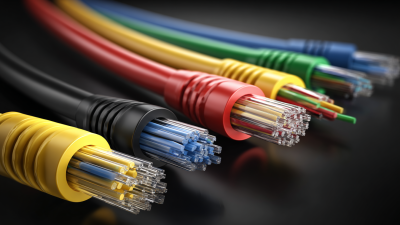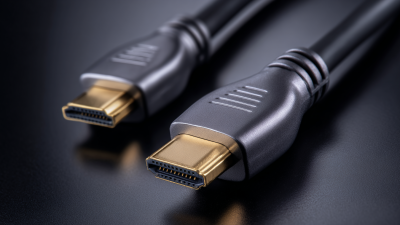Industries
Get direct access to our extensive portfolio of optical products and specialist technical expertise.
Get direct access to our extensive portfolio of optical products and specialist technical expertise.
As the demand for high-speed internet continues to surge, the deployment of fiber networks has become a critical focus for telecommunications providers worldwide. According to a report by ResearchAndMarkets, the global fiber optic market is projected to reach USD 44.45 billion by 2026, growing at a CAGR of 12.2% from 2021. However, deploying fiber networks is not without its challenges. Issues such as high installation costs, regulatory hurdles, and logistical difficulties can impede progress and affect service delivery. To address these common problems, it's essential to explore alternative strategies and solutions that can streamline the deployment process, enhance efficiency, and ultimately expand access to fiber network services for more communities. This blog will delve into these challenges and present viable alternatives to overcome them.

Fiber network deployment is a critical backbone for modern communication, yet it comes with a set of unique challenges that can hinder progress. One of the most common issues encountered during deployment is obtaining the necessary permits and right-of-way access. Various regulations and local policies can lead to delays, as project teams must navigate complex bureaucratic processes. Additionally, community resistance to construction activities can further complicate matters, making stakeholder engagement a vital aspect of successful deployment.
Another significant challenge lies in the physical installation of fiber optics themselves. Factors such as harsh weather conditions, difficult terrain, and existing infrastructure can pose risks to the timely and safe installation of fiber. To address these challenges, companies often utilize advanced planning and robust project management strategies to anticipate potential setbacks. Implementing thorough training for installation crews can also enhance their ability to adapt to unexpected issues in the field, ensuring a smoother deployment process. By understanding these common hurdles and strategically planning for them, organizations can optimize their fiber network projects and enhance connectivity for end users.
| Challenge | Description | Possible Solutions |
|---|---|---|
| High Deployment Costs | The initial expense of laying fiber optics can be prohibitively expensive. | Explore public-private partnerships and government grants; consider phased deployments. |
| Permitting and Regulatory Hurdles | Obtaining the necessary permits can be a time-consuming process. | Engage with local authorities early; streamline the permitting process through good communication. |
| Installation Challenges | Technical difficulties in installation can delay deployment. | Utilize experienced contractors; provide thorough training for installation teams. |
| Limited Skilled Labor | There is a shortage of trained professionals for fiber network work. | Invest in training programs; collaborate with local technical schools. |
| Maintenance and Upgrades | Ongoing maintenance and the need for upgrades can complicate long-term sustainability. | Implement a regular maintenance schedule; plan for future-proof infrastructure from the start. |
Deploying fiber networks can be a complex endeavor fraught with technical challenges. One of the key issues often encountered during fiber installation is the difficulty in navigating existing infrastructure. Old utility poles, buried cables, and other utility lines can pose significant obstacles. To mitigate this, conducting a thorough pre-installation survey is critical. By mapping out existing utilities and identifying potential conflicts, teams can plan routes more effectively and reduce delays during the installation process.
Another common technical hurdle is ensuring the integrity of the fiber during installation. Fiber optic cables are fragile and can be easily damaged if not handled properly. It’s essential to employ skilled technicians who are trained in proper handling and installation techniques. Additionally, utilizing protective conduits can help safeguard the cables from environmental factors and physical damage.
Finally, connectivity issues can arise due to improper splicing or termination of fiber cables. To overcome this challenge, investing in high-quality splicing tools and training for technicians is vital. Regular fiber testing with specialized equipment can also ensure that installations meet performance specifications and help identify issues before they lead to service interruptions.

In the competitive landscape of telecommunications, minimizing downtime during fiber network deployment is crucial. Reports indicate that network disruptions can lead to significant revenue loss; specifically, the average cost of downtime is estimated at around $5,600 per minute for businesses (Gartner, 2021). To mitigate these challenges, operators must adopt effective strategies that ensure swift resolution of any issues that may arise during installation and maintenance.
One essential tip is to invest in thorough training programs for technicians, focusing on troubleshooting and rapid response techniques. A well-equipped team can identify and solve problems quickly, reducing potential outages. Additionally, implementing advanced monitoring tools that provide real-time data can help significantly. Such tools enable proactive management, allowing teams to anticipate issues before they escalate, ensuring a smooth deployment process.
Another solution is to conduct extensive pre-deployment surveys and planning, which can unveil potential challenges even before installation begins. According to a report by the Fiber Broadband Association, systematic and detailed planning can minimize deployment delays by approximately 30%. By effectively preparing and doing groundwork, operators can greatly reduce the frequency and duration of network downtimes during fiber network rollouts.

Deploying fiber networks comes with its own set of challenges, particularly in navigating the complex landscape of regulatory and permitting hurdles. These challenges can significantly delay projects and inflate costs, making it crucial for companies to develop effective strategies to overcome them.
Tip: Engage early with local authorities to understand the specific requirements and procedures in your area. Establishing a line of communication can help address potential issues before they become roadblocks. Regular meetings and clear documentation can also facilitate a smoother permitting process.
Another effective strategy is to conduct thorough research on zoning laws and regulations prior to deployment. This preparation allows companies to anticipate challenges and gather necessary documentation in advance, expediting approvals.
Tip: Consider leveraging the expertise of consultants who specialize in regulatory compliance. They can provide valuable insights and help navigate the permitting process more efficiently, saving time and resources over the long run. By adopting these strategies, companies can better position themselves to tackle the regulatory landscape and ensure successful fiber network deployment.
In the rapidly evolving landscape of
fiber network deployment, enhancing collaboration among stakeholders is paramount for overcoming the myriad challenges that arise. According to the
Fiber Broadband Association, over 80% of network operators cite issues related to coordination and communication as significant barriers to successful project completion. This emphasizes the
critical need for a collaborative framework that brings together service providers, contractors, and local governments early in the planning process, ensuring that all parties are aligned on objectives and timelines.
Moreover, a recent report from the
Telecommunications Industry Association highlights that coordinated efforts can reduce deployment timelines by
up to 30%. By fostering transparent dialogue and utilizing collaborative project management tools, stakeholders can streamline processes and mitigate risks associated with delays and budget overruns. Emphasizing ongoing engagement and regular updates not only builds trust among participants but also enhances project adaptability, enabling teams to respond swiftly to unexpected challenges. The integration of advanced technologies and shared platforms is thus essential in paving the way for a more efficient and successful fiber network rollout.





